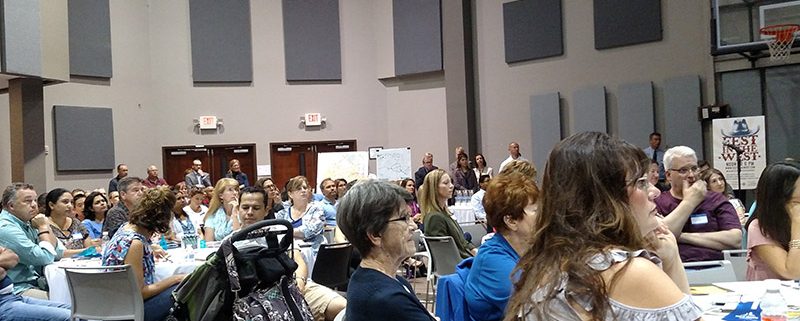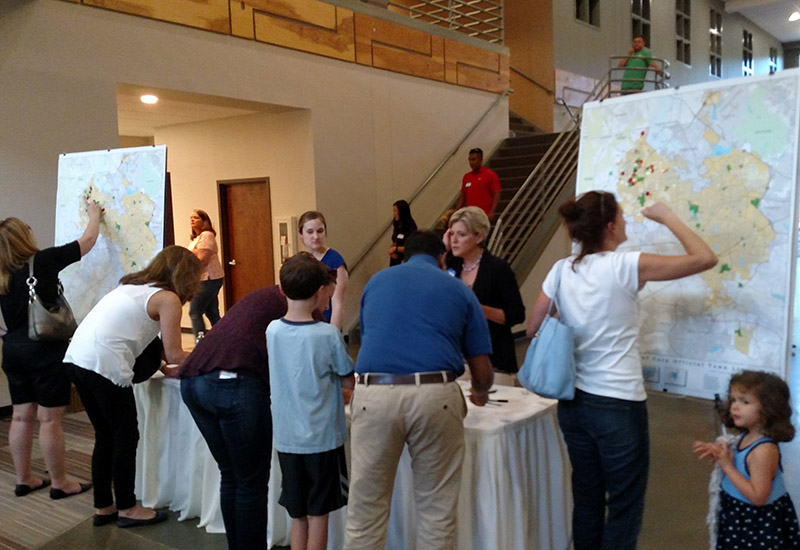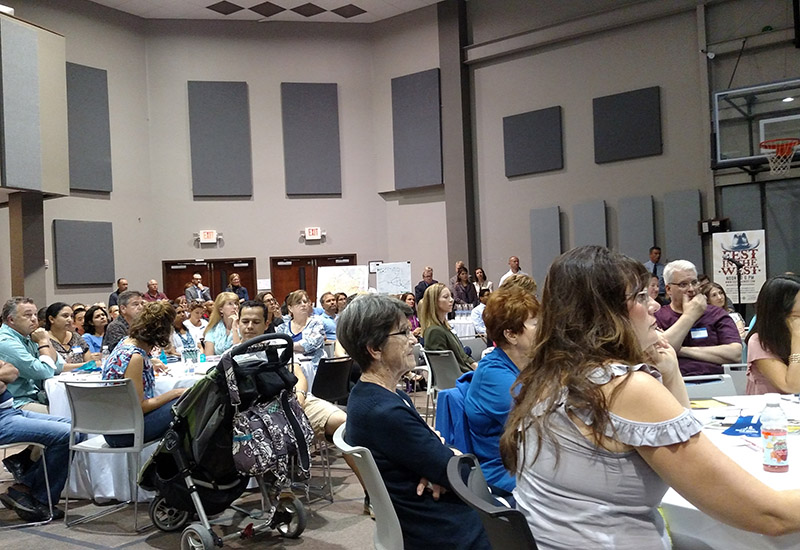West Cary Learns Information, Shares Concerns at Town Meeting
Cary, NC – As the piece of Cary with the most left undeveloped, West Cary is a rapidly growing part of not only the town but of Wake County. And with that growth comes new challenges and opportunities and the community shared both at a recent Cary information meeting.
Start of New Conversations
Space on Tuesday, May 2, 2017 was almost standing-room only as West Cary residents packed into Crosspointe Church to hear from Cary Town Council, the town manager and other members of the town staff. Much of this process about West Cary started with the new group, the Northwest Cary Community Connection, started by resident Nathaniel Greene.
“When the budget was being decided, I didn’t agree with some of the decisions in there,” Greene said. “I said the analysis should be done differently.”
Greene, who talked about the need for parks and community centers in West Cary at multiple Town Council meetings, said his criticisms lead to Parks, Recreation and Cultural Resources Director Doug McRainey encouraging him to engage with the town. Now, Greene is working to facilitate further discussions between the town government and West Cary about the community’s wants and needs.
“It’s easy to say ‘I don’t like how things are going,'” said Councilmember Jennifer Robinson, who represents most of West Cary. “It’s another thing to stand up and work for change.”
Town Manager Sean Stegall also talked about his goal of continuing conversation between the municipality and the various communities in Cary. One of the changes he is putting into place is making budget discussions ongoing.
“A town must, by law, adopt a budget once a year but it can be amended over time,” Stegall said.
There will be two public budget meetings in the coming months: Thursday, May 25 and Thursday, June 8, 2017. Locations and times to come.
“It should never be seen as an end and a beginning,” Stegall said. “It should be seen as an on-going discussion.”
The meeting venue, Crosspointe Church, is connected to what will be the new Northwest Cary YMCA, which is under construction. Brad Emory, the future director of the NW Cary Y, said it will be a 65,000 square foot facility and plans for it to open in the next three-to-four months.
“It’s unlike any YMCA we have in our association and really unlike any in the country,” Emory said.
What Is Here and What Is Coming
Much of the presentation by the Town of Cary focused on what currently exists in West Cary in terms of Parks and Recreation facilities and roadways. Around the gathering space in the church, posters and maps were set up showing the Parks and Recreation master plan, transportation and bus route maps, the Imagine Cary plan, and information about fire stations and the new Fire Station #8.
McRainey started by talking about the goal of connecting all of Cary’s greenways and parks, and ultimately linking all greenways in the region. Currently, 45 percent of Cary’s parks and 58 percent of its greenways are in West Cary. Additionally, of the future parks that are planned, 47 percent will be in West Cary.
Among those in West Cary include the USA Baseball Complex, the Cary Tennis Park, the American Tobacco Trail and the White Oak Trail, as well as the new Carpenter Park and New Hope Church Trailhead Park. Much of this open space in West Cary was bought early before fully planning for development but as McRainey said, this ended up saving the town a lot of money.
“The cost of this open space was $31 million when we bought it. Now it’s $117 million,” McRainey said. “That’s a saving of more than $80 million.”
McRainey also addressed the gaps that exist in the greenway system and said, as a trade-off for the 79 total miles of length, the construction process left in these disconnected portions.
Jerry Jensen, acting director of Transportation and Facilities in Cary, talked briefly about the history of roads in West Cary. In 2000, it was a mostly rural area and NC-55 was a two-lane road. Now, not only have NC-55 and High House Road been widened but there is NC-540, as well as more water lines, sewer lines and a pump station.
As far as future road projects in West Cary, Jensen listed the realignment and widening of Carpenter Fire Station Road. This would involve closing two rail crossings, but one would be added on O’Kelly Chapel Hill Road, which is also being widened.
One item that got buzz from the gathered crowd was a working of the Morrisville Parkway/Carpenter Upchurch Road intersection. Jensen said it will be opened up and there will be a traffic signal installed.
“I know a lot of your kids may use this intersection to get to school so this will make that safer,” Jensen said.
Other road projects include adding an interchange to Morrisville Parkway and building Green Level West Road to be a four-lane, median divided road with a bike lane.
McRainey also listed some future parks plans, including a park on Green Level Church Road and McCrimmon Parkway, the Panther Creek Greenway that will link to Mills Park, the White Oak Creek Greenway, the new cultivator Good Hope Farm and a phase two for Mills Park, which McRainey said was built using “input from teens” to make it more fun and modern.
Also, funding has been approved for the Mills Park Community Center.
Community Feedback
At the start of the meeting, Greene shared the results of a survey the Northwest Cary Community Connection sent out to residents, asking for their chief concerns about the area. At the top of the list were parks and greenways, local food and businesses and the Mills Park Community Center.
But when it came time for questions from the audience, many of the concerns dealt with the largest question of West Cary’s growing population and the resources needed to sustain it. The first speaker asked, with most parks being talked about in the presentation taking years to complete, how many more people will be in West Cary by then?
Town staff did not have a concrete number but Assistant Town Manager Russ Overton had one illuminating figure.
“There are 100 new homes a month in Cary. Not all of those are in West Cary but most are,” Overton said.
Robinson said population growth is considered in all infrastructure planning and said growth in Cary is currently about 3 percent, compared to nearly 15 percent in the 1990s.
Another question also touched on growth and specifically density. Cary’s land use plans have Northwest Cary designated as high density but one speaker said she did not want this, feeling the local roads and schools cannot handle the size. Several audience members applauded these comments.
Robinson said land that has been rezoned from the filler “R-40” designation is mostly set but with much of the 17 percent undeveloped land in Cary laying in the west, there were still options.
“Until that land is requested for rezoning, there is latitude,” Robinson said.
Two other speakers shared concerns about schools in West Cary, and in Wake County in general, with little room left available.
“Cary doesn’t have the authority to build schools,” Robinson said. “But some state charters have expressed an interest in being in Cary.”
She shared stories of the ways Cary has attempted to add schools, from various means of pressuring developers and builders, but said a large part of the problem is the high price and limited availability of land currently in the area. There is even a possibility of building new schools in Chatham County and having West Cary students go there.
A final question asked about the pinch points, or heavy congestion areas, on West Cary’s roads. Jensen said there are plans for development around the area that will hopefully fill many of those gaps but there are still places where development is unlikely. For those spots, Jensen said they would need to look for local or state funding.
“There’s a lot of asphalt that’s not being used,” Jensen said.
To keep the conversation going, Stegall encouraged anyone with more questions and concerns to email the town at feedback@townofcary.org and promised someone would get back to them.
Story and photos by Michael Papich.







The population density was (twice) addressed. The NW Plan adopted estimated a population between 25,000 to 45,000 with the final number most likely in the middle.